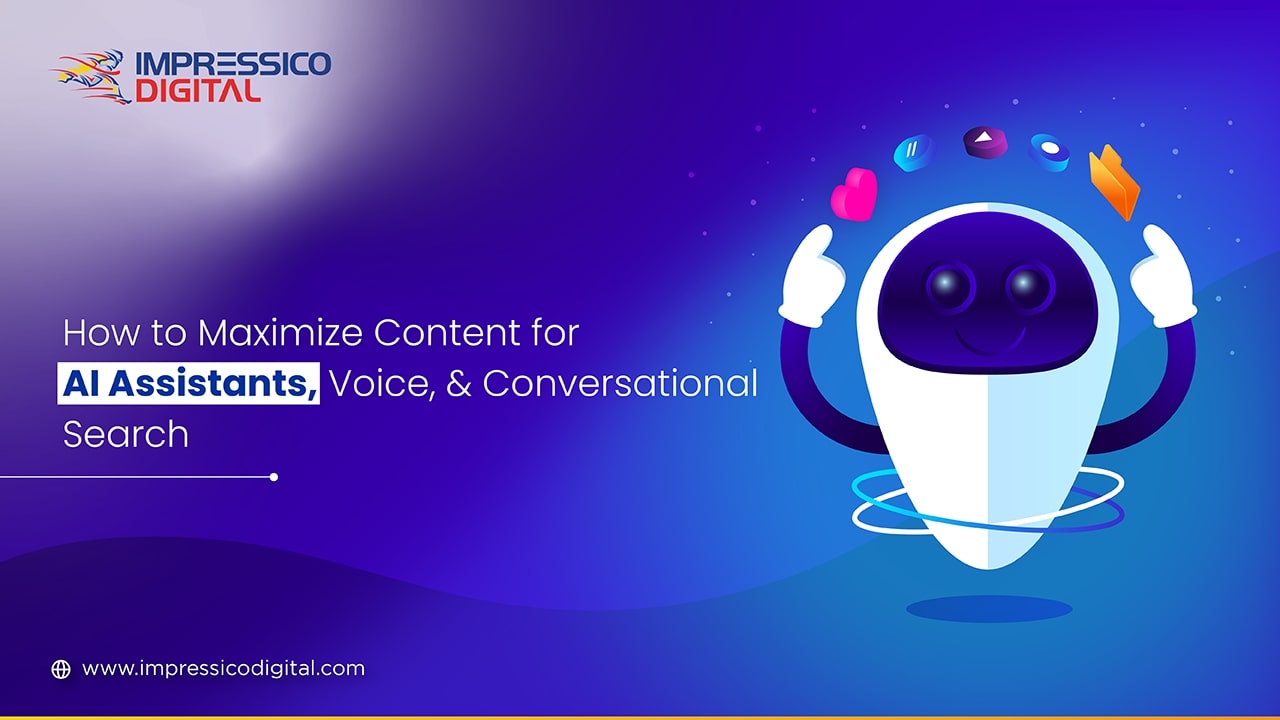How consumers search on the internet is evolving rapidly. Rather than typing a handful of keywords, ever-increasing numbers of users are entering full questions, speaking out, or conversing with AI assistants. That change is prompting something known as conversational search and positioning voice search and AI assistants at the forefront of content visibility. In order to remain ahead, businesses need to discover ways of optimizing content for AI assistants—that is, more than just SEO.
What Is Conversational Search?
Conversational search is when search engines or AI systems understand queries entered in natural, conversational language—frequently as complete sentences or questions—instead of chopped-up keyword strings. It understands context, follow-ups, and unclear queries, and frequently leverages prior interactions or implied intent.
For instance:
- Rather than typing “best electric car India”, a user may say: “What are the lowest priced electric cars available in India that have a range of more than 300 km on a single charge?”
- Or asking follow-ups: “Show me those priced below ₹20 lakh. What are their safety ratings?
This type of query not only uncovers keywords (“electric cars”, “affordable”, “300 km”), but the specific issues of concern to the user: price, range, safety. Search engine optimization for conversational search involves foreseeing those more elaborate, question-like searches, organizing content to provide direct answers, and supporting follow-ons. Most SEO practitioners now refer to this type of practice as AI SEO, Answer Engine Optimization (AEO), or Generative Engine Optimization (GEO)—preoccupation with how AI agents select, compile, and serve up content.
The Emergence of AI Assistants in 2025
In 2025, AI assistants are everywhere. ChatGPT, Google Gemini, Siri, Alexa, Perplexity, and others have become more powerful. They no longer just retrieve links—they summarize, respond to direct questions, and chat with users using natural language.
Here are some changes that shape the way we engage with content:
- Generative AI search (e.g., Google’s AI Overview, Search Generative Experience) is decreasing the number of clicks. AI assistants increasingly provide the answer straight away.
- Due to that, appearing as an authoritative source for AI assistants is as crucial (or more) than just ranking well in regular search results. Brands that are quoted by AI tools become visible even when users don’t click through. (Search Engine Land)
- Furthermore, AI assistants are being utilized more in everyday life—smartphones, home appliances, voice-enabled devices—so voice search is increasing in tandem with conversational and AI-powered search.
Therefore, to optimize for AI assistants in 2025 is to get content ready not just to rank, but to be utilized—to be pulled, quoted, summarized, spoken—by machines that respond to users.
Voice Search vs. Conversational Search vs. AI Assistants
These three concepts overlap, but they’re not identical.
| Input mode | Mainly spoken queries (voice commands) | Spoken or typed, multi-turn, natural language | Can include voice, text, multi-modal; interaction with an agent |
| Typical query style | “Hey Siri, where’s a coffee shop near me?” | “What are the best Italian restaurants in Delhi? What about vegetarian options?” | Includes context, follow-ups, personalized preferences, memory, etc. |
| Optimization focus | Speech recognition accuracy, local results, mobile friendliness, voice-friendly content | FAQs, long tail conversational queries, structured Q&A, context persistence | Entity optimization, authoritative, reliable sources, AI-friendly formats and metadata, minimizing barriers for bot access |
| Overlap | All require natural language, direct answers, structured content, fast performance, schema data. | Conversational search often powers voice and AI assistants. | AI assistants may use both conversational and voice search inputs and deliver voice or text-based answers. |
Knowing these differences aids in selecting which strategy to focus on first. A local coffee shop, for instance, will focus on voice search/local SEO; a knowledge platform or B2B content site might concentrate on conversational questions and AI assistant exposure.
Why AI Assistants and Voice Optimization Are Important
Below are the foremost reasons businesses should focus on this:
Brand visibility on AI Overviews / zero-click results: Consumers are more and more obtaining answers straight from AI assistants or search functionality that summarizes content, driving less traffic but increasing the value of being the source quoted.
Voice-driven mobile and local user engagement: Voice searches often include local intent (“near me”, “nearby”, etc.), so voice optimization enables companies to catch high-intent customers at the time.
Improved user experience and increased trust: Quick, accurate responses by reputable sources lead to increased credibility. This enhances retention, brand credibility, and repeat visits or mentions.
First-mover benefit: Not every company is executing this well yet. Early adopters can beat others in terms of areas AI is pointing to.
Future-proofing SEO strategies: With AI assistants becoming increasingly integrated and natural language processing dominating search engines, E-E-A-T (Experience, Expertise, Authoritativeness, Trustworthiness) and entity signals become increasingly relevant.
Core Principles of Optimization
When you’re optimizing for AI assistants, voice, and conversational search, these principles help lead the way:
Natural Q&A formats
Use questions as titles (H2, H3), and answer them obviously at the beginning of the section. Styles like FAQs or Q&A sections assist in matching the way people tend to ask questions.
Target long-tail and conversational questions
Consider what humans say, not what they write. Utilize tools such as “People Also Ask”, autocomplete tips, forums, and voice search-focused keyword tools.
Schema markup and structured data
Use FAQ schema, HowTo, LocalBusiness, Speakable, etc., so that it is easier for AI systems and search engines to parse important pieces of your content.
Optimize for featured snippets and zero-click placements
Show brief definitions or steps, employ the use of bullet points, and brief 40-50 word paragraphs in direct answers. Employ headers to ensure content is scannable.
Bolster local SEO for voice search
Make your Google Business Profile accurate, add NAP (Name, Address, Phone), incorporate local keywords, and post local content. Most voice searches are real-time, location-based.
Technical quality
Quick page load, mobile friendly, keep your site’s metadata well populated, HTML clean so bots can crawl, let AI crawlers use structured data (JSON-LD).
All of these increase your likelihood of being chosen by an AI assistant or voice search feature.
AI Assistant Optimization Strategies
The following are actionable suggestions you can implement today:
Answer formatting for clarity: Begin with the answer towards the beginning, and then elaborate. Use bullet points, step numbers, and bold headings. Ensure the answer to probable questions is apparent in the first 1–2 paragraphs.
Provide short, to-the-point answers: AI tools prefer clear, factual, direct speech. Don’t use padding. If a user asks, “How do I reset my password on Windows 11?”, a 1-2 sentence concise initial answer followed by details is good.
Set up authority with sources: Employ reputable external quotes, connect credible facts, quotes, and case studies. Add author bios, crediting credentials. This ties in with E-E-A-T, which AI-driven systems increasingly use.
Entity optimization: Entities are things: brands, people, places, and important concepts. Use them clearly: reference internal content, external mention, and be consistent. Use ‘entities’ instead of keywords. AI systems get relationships between entities.
Featured snippet capture: Find the questions asked by people (through keyword research / People Also Ask). Structure content such that those answers are evident (like a short paragraph, definition, or list). Use schema.
Ongoing optimization: Check how content is performing (see below for metrics), update content, refresh data, hone based on what AI assistants are accomplishing. AI platforms evolve, and so should your content.
Technical SEO for Voice and AI
Beyond content, technical foundations are essential:
Quick load times, mobile-first development: Voice and AI users expect rapid responses. Core Web Vitals, mobile responsiveness, low latency, reduced scripts, and resized images are all key.
Structured data / JSON-LD: Mark up FAQs, HowTo, LocalBusiness, Speakable, where possible. JSON-LD is typically preferred. It aids AI agents in being able to parse and extract the appropriate answer fragments.
Clean HTML, crawlability, metadata: Ensure your robots.txt does not prevent AI or voice bots, sitemaps are recent, and canonical tags are used correctly. Employ good title tags, meta descriptions, and heading hierarchies.
Permit AI crawlers: As discussed in AI optimization guides, permitting bots / AI agents to access your content is essential. Utilize llms.txt (when needed) or take care not to block AI sources by mistake.
Internal linking and site architecture: A Structured organization makes your site easier for AI to comprehend. Pillar pages, cluster pages. Entities linked together through links.
Metrics for Measuring Success
To determine if your AI assistant / voice / conversational search optimization is succeeding, monitor:
AI citations / occurrence: How often your website is being cited by AI overviews, voice assistants, and generative search summaries. Tools can indicate when your content is a featured snippet or used in AI summaries.
Voice search metrics: While it is hard to obtain precise figures, you can utilize the search console (with “query” filters), analytics for ‘zero-click’ traffic, utilization of voice keyword structures, and local traffic upticks.
Engagement metrics: Time on page, scroll depth, bounce rate; especially for pages designed for conversational responses. If individuals land and immediately receive the information, a little scroll and exit could indicate success for voice or AI assistants.
Zero-click impressions: Content appears in search results with answer boxes / AI summaries, but users may not click. While traffic may decline, visibility and brand authority grow.
Conversion or downstream actions: For local searches: calls, direction requests, bookings. For content: sign-ups, brand searches later. Even if a user doesn’t click to hear the answer from AI, later they might search for the brand.
Get a custom performance dashboard and AI visibility report — book your SEO Consultation today.
Challenges & Risks
Optimizing for voice and AI assistants has genuine value—but also risks:
Misattribution or wrong answers: AI assistants can quote or paraphrase poorly. If your content is misquoted, misused, or out of context, your brand gets harmed.
Lower website traffic: As zero-click results grow more common, people might click less; revenue models that rely solely on visits could be affected.
Loss of control over the brand: When AI systems can produce responses, your content may be paraphrased or summarized in a different way, potentially losing the nuance or tone.
Over-optimization / keyword oddity: Being too aggressive in attempting to fit voice query patterns may create stilted phrasing. Clarity and a natural-sounding voice are crucial.
Technical maintenance: Schema markup, structured data, page speed, and bot access need regular maintenance. If forgotten, broken markup or blocked bots can harm visibility.
The Future of AI, Voice & Conversational Search
Looking forward:
Multimodal & hybrid search experiences will become the norm: voice + camera + text + images. See, hear, speak assistants. Content will have to be multi-format.
Wiser conversational AI: Agents like Gemini, Perplexity, etc., will make better use of context, personalization, and past user behavior. Hence, optimizing for follow-ups, entities, and session continuity will become increasingly important.
Stronger AI Overviews & zero-click functionality: These will likely grow worldwide, in more languages, more territories. Being the go-to source on many subjects is increasingly important.
Voice / speech interfaces built into more devices: More IoT devices, in-car assistants, wearables. Your content will need to be optimized for short-form, audio-appropriate answers.
More emphasis on trust, transparency, and E-E-A-T: AI systems will more robustly assess content quality, authority, and recency. Brands will have to prove expertise, trustworthy sources, author identification, and fresh content.
In short, businesses will need to keep fine-tuning content for AI assistants not just as a one-time effort but as a perpetual strategy. Adaptation, tracking, and iteration will be what sets leaders apart from followers.
FAQ
- How do I optimize content for AI assistants like Siri and Alexa?
Prioritize natural, long-tail question phrasing; employ structured data (schema), early direct answers; provide voice-friendly copy; optimize for mobile and local; and affirm authority through solid sources.
- Is voice search optimization the same as optimizing for AI assistants?
They intersect but are not the same. Voice search is a mode (speaking vs typing), whereas optimizing for AI assistants entails conversational search, zero-click visibility, entity optimization, and being mentioned in AI summaries—not only spoken queries.
- What role does conversational search play in SEO?
It redefines the way content must be written: expecting follow-ups, managing context, speaking naturally, centered on user intent over keywords. It compels content to be more natural, authoritative, and question-answer oriented.
- What are the best strategies for voice search optimization in 2025?
Employ long-tail conversational searches; optimize for local search; use FAQ/HowTo schema; optimize fast mobile performance; deliver brief direct answers; track voice-specific engagement and AI citation signals.
- How does Google Gemini affect conversational SEO?
Gemini and other generative AI tools change which content is surfaced in summaries and conversational settings; content that is well-written, well-organized, credible, and entity-laden has a greater chance of being utilized. Expect that these platforms will increasingly favor content that anticipates user context and follow-ups.
- What metrics track success when optimizing for AI assistants?
AI citation rate; voice search query performance; zero-click impressions; local voice-driven actions (calls, directions); engagement metrics; downstream branded searches.
- Will AI assistants replace traditional search engines?
Not exactly. They complement them. Classic search remains relevant for many categories of users, discovery, browsing, and backlinks. But conversational/voice search and AI assistants are increasing very fast and redefining people’s expectations of accessing information.
If you are prepared to future-proof your content, make it visible, and make it trusted in the voice, conversational search, and AI assistant era, Impressico Digital can assist you. We optimize your content for AI agents, deploy schema markup, enhance your voice and local search footprint, and track what truly matters.
Contact us today, and let’s make sure your brand is one of the answers people hear first.
Want to know more about us? Follow us on social media!



